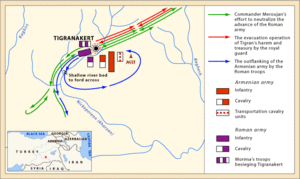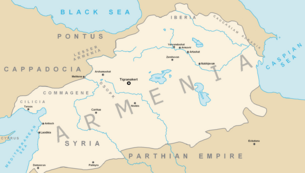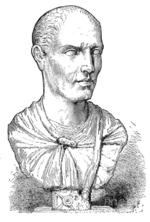Battle of Tigranocerta facts for kids
Quick facts for kids Battle of Tigranocerta |
|||||||
|---|---|---|---|---|---|---|---|
| Part of the Third Mithridatic War | |||||||
 |
|||||||
|
|||||||
| Belligerents | |||||||
| Roman Republic | Kingdom of Armenia | ||||||
| Commanders and leaders | |||||||
| Lucullus Legatus Fannius Legatus Sextilius Legatus Hadrianus |
Tigranes the Great Taxilés Mancaeus Mithrobarzanes |
||||||
| Strength | |||||||
|
11,000–40,000 men 10,000–24,000 infantry 1,000–3,300 Roman and 10,000 Galatian and Thracian cavalry Bithynian infantry |
70,000–100,000 men Adiabenians, Corduenians, Iberians, Medians 20,000–25,000 Armenians |
||||||
| Casualties and losses | |||||||
| Unknown, estimated light |
Unknown, estimates given from 10,000 to 100,000 5,000 killed 5,000 captured |
||||||
The Battle of Tigranocerta was a major fight between the Roman Republic and the Kingdom of Armenia. It happened on October 6, 69 BC. The Roman army was led by Lucius Licinius Lucullus, a Roman general. The Armenian army was led by their king, Tigranes the Great.
This battle was part of the Third Mithridatic War. This war was between Rome and Mithridates VI of Pontus. Mithridates was Tigranes' father-in-law. When Mithridates needed help, he went to Tigranes. Because of this, Rome decided to invade Armenia.
The Romans surrounded Tigranes' capital city, Tigranocerta. When the large Armenian army arrived, the Romans pretended to retreat. They crossed a nearby river. Then, they suddenly attacked the Armenian army's right side. The Romans defeated Tigranes' best soldiers, called cataphracts. The rest of the Armenian army, mostly new recruits, panicked and ran away. This gave the Romans a big victory.
Contents
Why the Battle Happened
King Tigranes the Great had built a huge Armenian empire. It stretched across much of the Near East. His father-in-law, Mithridates, helped protect his western borders. This allowed Tigranes to conquer lands in Parthia and Mesopotamia. He also took over lands in the Levant.
In Syria, Tigranes started building a new city. He named it Tigranocerta after himself. He brought many different people to live there. These included Arabs, Greeks, and Jews. The city quickly became his main base in Syria. It grew into a center for Greek culture. It had theaters, parks, and hunting grounds.
However, Rome was becoming very powerful. The Roman–Mithridatic Wars showed Rome's strength. The Third Mithridatic War was especially tough for Mithridates. The Roman general Lucullus pushed him back. Mithridates had to escape and seek safety with Tigranes.
Lucullus sent a messenger, Appius Claudius, to Tigranes. He demanded that Tigranes hand over Mithridates. If Tigranes refused, Rome would declare war on Armenia. Tigranes said no. He told Rome he would prepare for war.
Lucullus was surprised by Tigranes' refusal in 70 BC. He quickly got ready to invade Armenia. He didn't have official permission from the Senate. But he argued that Tigranes was the enemy, not the Armenian people. In the summer of 69 BC, Lucullus marched his troops. They crossed Cappodocia and the Euphrates river. They entered the Armenian province of Tsop'k', where Tigranocerta was located.
Surrounding Tigranocerta

Tigranes was in Tigranocerta in the summer of 69 BC. He was shocked by how fast Lucullus moved. He was also surprised that Lucullus had invaded at all. For a while, he couldn't believe it was happening.
Finally, Tigranes sent a general named Mithrobarzanes. He had 2,000 to 3,000 cavalry soldiers. Their job was to slow Lucullus down. But Lucullus's 1,600 cavalry, led by Sextilius, easily defeated them. Mithrobarzanes' forces were completely destroyed.
When Tigranes heard about this defeat, he left Tigranocerta. He put Mancaeus in charge of defending the city. Tigranes went to the Taurus Mountains to gather a larger army. Lucullus's officers stopped two groups of Armenian soldiers trying to help Tigranes. They even found and fought Tigranes' forces in a canyon. Lucullus decided not to chase Tigranes. Instead, he marched straight to Tigranocerta and began to surround it.
Tigranocerta was not yet finished when Lucullus arrived. It was still a very strong city. The Greek historian Appian said its walls were thick and 25 meters (about 82 feet) high. This made it very hard to attack. The Romans used Roman siege engines to try and break through. But the defenders fought back with naphtha. This was a flammable liquid. Some historians believe this was one of the first uses of chemical warfare.
However, Tigranes had forced many people to move to Tigranocerta. They were not loyal to him. When Tigranes and his army appeared on a hill, these people showed their true feelings. They cheered for the Romans. They pointed out the Armenian army from the city walls.
The Armies Face Off
Historians have different ideas about the size of the armies.
Lucullus's Roman army was smaller. Some say he started with one legion from Rome. He added four more legions in Anatolia. This would mean about 30,000 infantry and 1,600 cavalry. When he invaded Armenia, some sources say he had only two legions and 500 horsemen. But this seems too small for such a big invasion. Other estimates say Lucullus had about 16,000 heavy infantry and 1,000 cavalry, slingers, and archers. About 6,000 of his heavy infantry did not fight in the battle. Some historians believe his force was around 12,000 experienced legionaries. He also had 4,000 cavalry and light infantry from the provinces. The Roman army also had thousands of allied soldiers. These included Galatians, Thracians, and Bithynians. This could bring his total strength to about 40,000 soldiers.
Tigranes' Armenian army was much larger. Some sources claim it had 250,000 infantry and 50,000 cavalry. Others say 225,000 soldiers and 35,000 non-fighters. Some even claim 600,000 cavalry and 100,000 infantry. Most historians think these numbers are too high. They believe the numbers were greatly exaggerated.
One story says Tigranes thought Lucullus's army was tiny. He supposedly said, "If they come as ambassadors, they are too many; if they are soldiers, too few." This line might not be true, but it shows the difference in army sizes. A modern estimate puts Tigranes' army at 80,000 to 100,000 men. Tigranes also had thousands of cataphracts. These were powerful heavily armored cavalry. They wore mail armor and carried lances, spears, or bows.
The Battle Begins

The two armies met near the Batman-Su river. This was just southwest of Tigranocerta.
Tigranes' army was on the east side of the river. Lucullus was on the west side. Lucullus had left 6,000 heavy infantry behind. They were still surrounding Tigranocerta. The Armenian army had three parts. Two of Tigranes' vassal kings led the left and right sides. Tigranes himself led his cataphracts in the middle. The rest of his army stood in front of a hill. Lucullus quickly saw how to use this hill to his advantage.
Some Roman soldiers were worried about fighting that day. October 6 was the anniversary of the terrible battle of Arausio. In that battle, a Roman army was crushed by Germanic tribes. But Lucullus ignored their fears. He famously said, "Verily, I will make this day, too, a lucky one for the Romans."
Lucullus decided to spread his army out. He wanted to make his battle line as wide as possible. This would help against the Armenian cavalry. He took some of his troops downriver. This was where the river was easiest to cross. Tigranes thought Lucullus was retreating.
Lucullus had planned a "running charge" with his infantry. This Roman tactic meant they would run quickly at the enemy. This would give enemy archers and slingers less time to shoot. But at the last moment, Lucullus changed his mind. He realized the Armenian cataphracts were the biggest threat. He ordered his Gallic and Thracian cavalry to attack the cataphracts. This was a diversion.
While the cataphracts were busy, Lucullus moved two groups of his soldiers. He ordered them to cross the river. His plan was to go around the hill. Then, he would attack Tigranes' cataphracts from behind.
Lucullus personally led the charge on foot. When he reached the top of the hill, he shouted to his soldiers. He wanted to boost their spirits. "The day is ours, the day is ours, my fellow soldiers!" he yelled. He gave special orders to his soldiers. They were to attack the horses' legs and thighs. These were the only parts of the cataphracts that were not armored.
Lucullus charged downhill with his soldiers. His orders worked perfectly. The slow-moving cataphracts were caught by surprise. As they tried to escape, they crashed into their own lines. The Armenian army began to fall apart.
The Armenian infantry was also made up of many non-Armenians. They started to break ranks. Confusion spread through Tigranes' entire army. King Tigranes himself fled north with his supplies. His whole army collapsed.
What Happened Next
With no army left, Tigranocerta was defenseless. The people inside the city, who were not loyal to Tigranes, happily opened the gates to the Romans. Lucullus's army then looted and plundered the city. The city was also burned.
The king's treasury was huge. It was worth about 8,000 talents (a large amount of money). Each Roman soldier received 800 drachma (a type of coin). The battle also meant Armenia lost a lot of land. Most of Tigranes' empire south of the Taurus Mountains came under Roman control.
Even with these heavy losses, the war was not over. Tigranes and Mithridates escaped north. They managed to avoid Lucullus's forces. They even fought the Romans again at the Battle of Artashat, losing once more. In 68 BC, Lucullus's soldiers started to complain. They wanted to go home. So, Lucullus pulled his troops out of Armenia the next year.
Many historians talk about this battle. They highlight how Lucullus won despite being outnumbered. The Italian thinker Niccolò Machiavelli wrote about it in his book, The Art of War. He criticized Tigranes for relying too much on his cavalry and not enough on his infantry.
Soldiers Lost
The number of soldiers lost by Tigranes' army varies greatly. Estimates range from 10,000 to as many as 100,000 men. Some sources say 5,000 were killed and 5,000 captured. Others claim 30,000 losses. Plutarch said 100,000 infantry were killed. He also said almost all the cavalry was wiped out.
For the Roman side, Plutarch claimed "only a hundred were wounded, and only five killed." These numbers are likely too low to be true. However, it is clear that the Romans won with very few losses compared to the Armenians.

